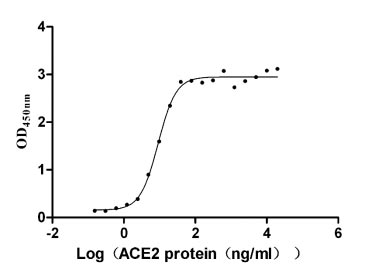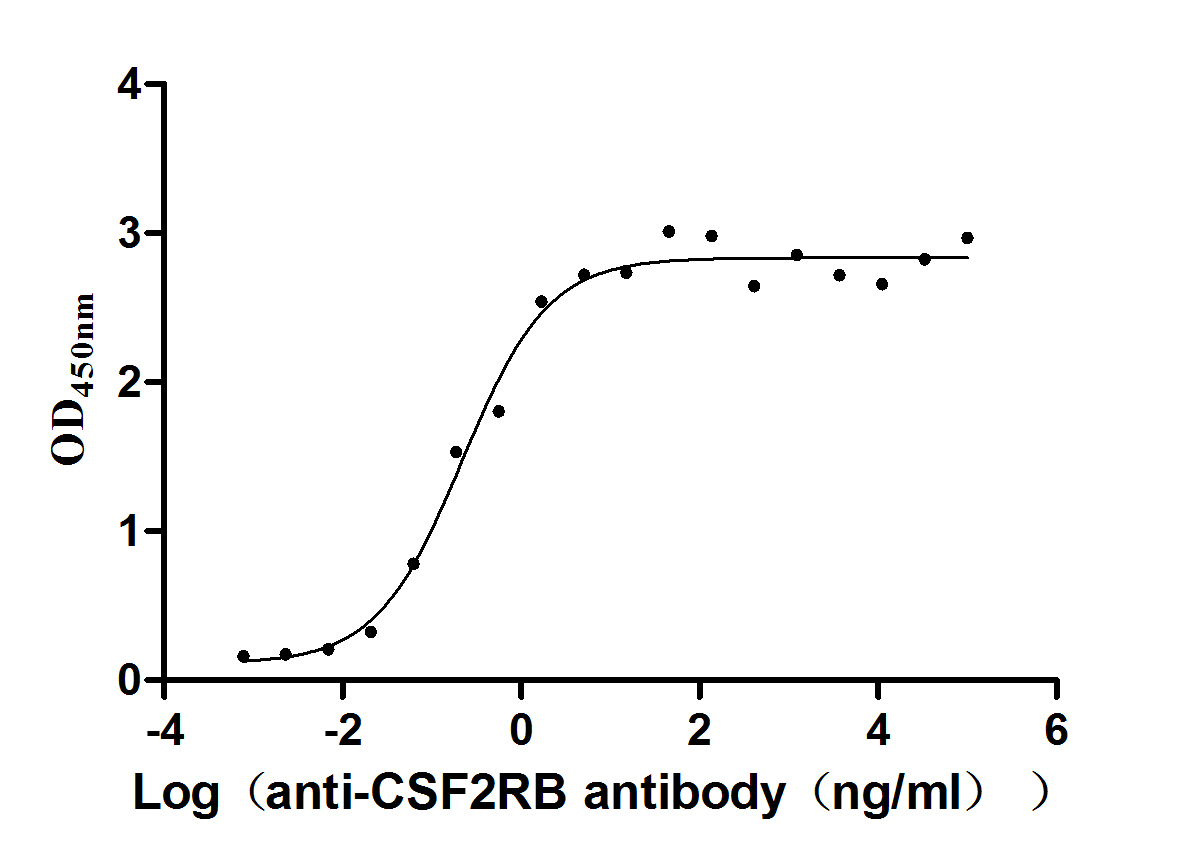Recombinant Mouse Probable fructose-2,6-bisphosphatase TIGAR (Tigar)
-
中文名称:小鼠Tigar重组蛋白
-
货号:CSB-YP805369MO
-
规格:
-
来源:Yeast
-
其他:
-
中文名称:小鼠Tigar重组蛋白
-
货号:CSB-EP805369MO
-
规格:
-
来源:E.coli
-
其他:
-
中文名称:小鼠Tigar重组蛋白
-
货号:CSB-EP805369MO-B
-
规格:
-
来源:E.coli
-
共轭:Avi-tag Biotinylated
E. coli biotin ligase (BirA) is highly specific in covalently attaching biotin to the 15 amino acid AviTag peptide. This recombinant protein was biotinylated in vivo by AviTag-BirA technology, which method is BriA catalyzes amide linkage between the biotin and the specific lysine of the AviTag.
-
其他:
-
中文名称:小鼠Tigar重组蛋白
-
货号:CSB-BP805369MO
-
规格:
-
来源:Baculovirus
-
其他:
-
中文名称:小鼠Tigar重组蛋白
-
货号:CSB-MP805369MO
-
规格:
-
来源:Mammalian cell
-
其他:
产品详情
-
纯度:>85% (SDS-PAGE)
-
基因名:
-
Uniprot No.:
-
别名:Tigar; Fructose-2,6-bisphosphatase TIGAR; EC 3.1.3.46; TP53-induced glycolysis and apoptosis regulator; TP53-induced glycolysis regulatory phosphatase
-
种属:Mus musculus (Mouse)
-
蛋白长度:full length protein
-
表达区域:1-269
-
氨基酸序列MPRFALTVIR HGETRLNKEK IIQGQGVDAP LSETGFRQAA AAGQFLSNVQ FTHAFSSDLT RTKQTIHGIL EKSRFCKDMA VKYDSRLRER MYGVAEGKPL SELRAMAKAA GEECPMFTPP GGETVEQVKM RGKDFFDFIC QLILGKAGQR ESVLPGAPGS GLESSLAEVF PVGKHGSLGA NPKGGTLGLA ASILVVSHGA YMRSLFGYFL SDLRCSLPGA RDKLELSSIT PNTGISVFII DCEEARQPSI QCVCMNLQEH LNGVTEKQH
-
蛋白标签:Tag type will be determined during the manufacturing process.
The tag type will be determined during production process. If you have specified tag type, please tell us and we will develop the specified tag preferentially. -
产品提供形式:Lyophilized powder
Note: We will preferentially ship the format that we have in stock, however, if you have any special requirement for the format, please remark your requirement when placing the order, we will prepare according to your demand. -
复溶:We recommend that this vial be briefly centrifuged prior to opening to bring the contents to the bottom. Please reconstitute protein in deionized sterile water to a concentration of 0.1-1.0 mg/mL.We recommend to add 5-50% of glycerol (final concentration) and aliquot for long-term storage at -20℃/-80℃. Our default final concentration of glycerol is 50%. Customers could use it as reference.
-
储存条件:Store at -20°C/-80°C upon receipt, aliquoting is necessary for mutiple use. Avoid repeated freeze-thaw cycles.
-
保质期:The shelf life is related to many factors, storage state, buffer ingredients, storage temperature and the stability of the protein itself.
Generally, the shelf life of liquid form is 6 months at -20°C/-80°C. The shelf life of lyophilized form is 12 months at -20°C/-80°C. -
货期:Delivery time may differ from different purchasing way or location, please kindly consult your local distributors for specific delivery time.Note: All of our proteins are default shipped with normal blue ice packs, if you request to ship with dry ice, please communicate with us in advance and extra fees will be charged.
-
注意事项:Repeated freezing and thawing is not recommended. Store working aliquots at 4°C for up to one week.
-
Datasheet :Please contact us to get it.
靶点详情
-
功能:Fructose-bisphosphatase hydrolyzing fructose-2,6-bisphosphate as well as fructose-1,6-bisphosphate. Acts as a negative regulator of glycolysis by lowering intracellular levels of fructose-2,6-bisphosphate in a p53/TP53-dependent manner, resulting in the pentose phosphate pathway (PPP) activation and NADPH production. Contributes to the generation of reduced glutathione to cause a decrease in intracellular reactive oxygen species (ROS) content, correlating with its ability to protect cells from oxidative or metabolic stress-induced cell death. Plays a role in promoting protection against cell death during hypoxia by decreasing mitochondria ROS levels in a HK2-dependent manner through a mechanism that is independent of its fructose-bisphosphatase activity. In response to cardiac damage stress, mediates p53-induced inhibition of myocyte mitophagy through ROS levels reduction and the subsequent inactivation of BNIP3. Reduced mitophagy results in an enhanced apoptotic myocyte cell death, and exacerbates cardiac damage. Plays a role in adult intestinal regeneration; contributes to the growth, proliferation and survival of intestinal crypts following tissue ablation. Plays a neuroprotective role against ischemic brain damage by enhancing PPP flux and preserving mitochondria functions. Protects glioma cells from hypoxia- and ROS-induced cell death by inhibiting glycolysis and activating mitochondrial energy metabolism and oxygen consumption in a TKTL1-dependent and p53/TP53-independent manner. Plays a role in cancer cell survival by promoting DNA repair through activating PPP flux in a CDK5-ATM-dependent signaling pathway during hypoxia and/or genome stress-induced DNA damage responses. Involved in intestinal tumor progression.
-
基因功能参考文献:
- Study demonstrated that TIGAR played a positive role in survival of astrocytes and a negative role in inflammatory response after stroke attack. TIGAR exerted these functions through increasing flux of pentose phosphate pathway and inhibiting NF-kappaB activation. PMID: 29331305
- TIGAR contributes to ischemic tolerance induced by cerebral preconditioning through scavenging of reactive oxygen species and inhibition of apoptosis. PMID: 27256465
- Results suggest that TIGAR expression changes during development and its expression level may be correlated with the vulnerability of neurons to ischemic injury. PMID: 26219221
- Although mouse TIGAR expression is clearly induced in the intestines of mice following DNA-damaging stress of ionizing radiation, that was not dependent on p53 or TAp73. PMID: 26247727
- TIGAR protein expression in brain is increased following ischemia reperfusion injury. PMID: 25445985
- Therefore, we conclude that TIGAR knockdown-induced radiosensitization of glioma cells may be dependent on the inhibition of TRX1 nuclear translocation. PMID: 24509157
- TIGAR protects ischemic brain injury and preserves mitochodrial function. PMID: 24872551
- TIGAR has roles in efficient intestinal regeneration and tumorigenesis PMID: 23726973
- p53/TIGAR-mediated inhibition of myocyte mitophagy is responsible for impairment of mitochondrial integrity and subsequent apoptosis. PMID: 22044588
- p53 and TIGAR inhibit glycolysis in hypoxic myocytes and that inhibition of glycolysis is closely involved in apoptosis, suggesting that p53 and TIGAR are significant mediators of cellular energy homeostasis and cell death under ischemic stress. PMID: 20935145
显示更多
收起更多
-
亚细胞定位:Cytoplasm. Nucleus. Mitochondrion.
-
蛋白家族:Phosphoglycerate mutase family
-
组织特异性:Expressed in olfactory bulb, cerebellum, and cortex. Expressed in neurons and astrocytes (at protein level). Expressed in intestinal crypt.
-
数据库链接:
KEGG: mmu:319801
STRING: 10090.ENSMUSP00000048643
UniGene: Mm.101836
Most popular with customers
-
Recombinant Human SARS coronavirus Spike glycoprotein (S), partial (Active)
Express system: Mammalian cell
Species: Human SARS coronavirus (SARS-CoV) (Severe acute respiratory syndrome coronavirus)
-
Recombinant Human Cytokine receptor common subunit beta (CSF2RB), partial (Active)
Express system: Mammalian cell
Species: Homo sapiens (Human)
-
Recombinant Human T-cell surface protein tactile (CD96), partial (Active)
Express system: Mammalian cell
Species: Homo sapiens (Human)
-
Recombinant Mouse Prolactin receptor (Prlr), partial (Active)
Express system: Mammalian cell
Species: Mus musculus (Mouse)
-
Recombinant Rabbit Tissue factor pathway inhibitor (TFPI) (Active)
Express system: Mammalian cell
Species: Oryctolagus cuniculus (Rabbit)
-
Recombinant Macaca fascicularis lymphocyte antigen 6 family member G6D (LY6G6D) (Active)
Express system: Yeast
Species: Macaca fascicularis (Crab-eating macaque) (Cynomolgus monkey)
-
Recombinant Human CD81 antigen (CD81), partial (Active)
Express system: Mammalian cell
Species: Homo sapiens (Human)
-
Recombinant Macaca fascicularis CUB domain containing protein 1 (CDCP1), partial (Active)
Express system: Mammalian cell
Species: Macaca fascicularis (Crab-eating macaque) (Cynomolgus monkey)




-AC1.jpg)















